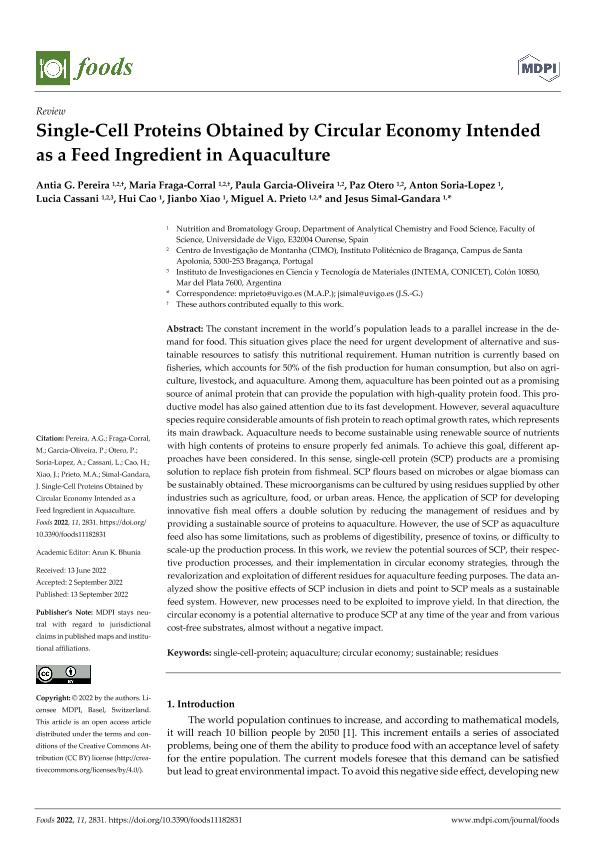Artículo
Single-Cell Proteins Obtained by Circular Economy Intended as a Feed Ingredient in Aquaculture
Pereira, Antia G.; Fraga Corral, Maria; Garcia Oliveira, Paula; Otero, Paz; Soria Lopez, Anton; Cassani, Lucía Victoria ; Cao, Hui; Xiao, Jianbo; Prieto, Miguel A.; Simal Gándara, Jesús
; Cao, Hui; Xiao, Jianbo; Prieto, Miguel A.; Simal Gándara, Jesús
 ; Cao, Hui; Xiao, Jianbo; Prieto, Miguel A.; Simal Gándara, Jesús
; Cao, Hui; Xiao, Jianbo; Prieto, Miguel A.; Simal Gándara, Jesús
Fecha de publicación:
09/2022
Editorial:
Multidisciplinary Digital Publishing Institute
Revista:
Foods
e-ISSN:
2304-8158
Idioma:
Inglés
Tipo de recurso:
Artículo publicado
Clasificación temática:
Resumen
The constant increment in the world’s population leads to a parallel increase in the demand for food. This situation gives place the need for urgent development of alternative and sustainable resources to satisfy this nutritional requirement. Human nutrition is currently based on fisheries, which accounts for 50% of the fish production for human consumption, but also on agriculture, livestock, and aquaculture. Among them, aquaculture has been pointed out as a promising source of animal protein that can provide the population with high-quality protein food. This productive model has also gained attention due to its fast development. However, several aquaculture species require considerable amounts of fish protein to reach optimal growth rates, which represents its main drawback. Aquaculture needs to become sustainable using renewable source of nutrients with high contents of proteins to ensure properly fed animals. To achieve this goal, different approaches have been considered. In this sense, single-cell protein (SCP) products are a promising solution to replace fish protein from fishmeal. SCP flours based on microbes or algae biomass can be sustainably obtained. These microorganisms can be cultured by using residues supplied by other industries such as agriculture, food, or urban areas. Hence, the application of SCP for developing innovative fish meal offers a double solution by reducing the management of residues and by providing a sustainable source of proteins to aquaculture. However, the use of SCP as aquaculture feed also has some limitations, such as problems of digestibility, presence of toxins, or difficulty to scale-up the production process. In this work, we review the potential sources of SCP, their respective production processes, and their implementation in circular economy strategies, through the revalorization and exploitation of different residues for aquaculture feeding purposes. The data analyzed show the positive effects of SCP inclusion in diets and point to SCP meals as a sustainable feed system. However, new processes need to be exploited to improve yield. In that direction, the circular economy is a potential alternative to produce SCP at any time of the year and from various cost-free substrates, almost without a negative impact.
Palabras clave:
AQUACULTURE
,
CIRCULAR ECONOMY
,
RESIDUES
,
SINGLE-CELL-PROTEIN
,
SUSTAINABLE
Archivos asociados
Licencia
Identificadores
Colecciones
Articulos(INTEMA)
Articulos de INST.DE INV.EN CIENCIA Y TECNOL.MATERIALES (I)
Articulos de INST.DE INV.EN CIENCIA Y TECNOL.MATERIALES (I)
Citación
Pereira, Antia G.; Fraga Corral, Maria; Garcia Oliveira, Paula; Otero, Paz; Soria Lopez, Anton; et al.; Single-Cell Proteins Obtained by Circular Economy Intended as a Feed Ingredient in Aquaculture; Multidisciplinary Digital Publishing Institute; Foods; 11; 18; 9-2022; 1-22
Compartir
Altmétricas



